-
Countries
-
Data and Analysis
-
Special Focus
-
Crisis Responses
Contact
DTM Libya, DTMLibya@iom.int
Language
English
Location
Libya
Snapshot Date
Sep 30 2023
Activity
- Mobility Tracking
- Site Assessment
Detention Centre Profiling is a component of IOM Libya’s Displacement Matrix programme. It is a data oriented tool that routinely provides specific sex and age demographic data and key sectorial information on individuals held in Libya’s detention centres on the date of assessment.
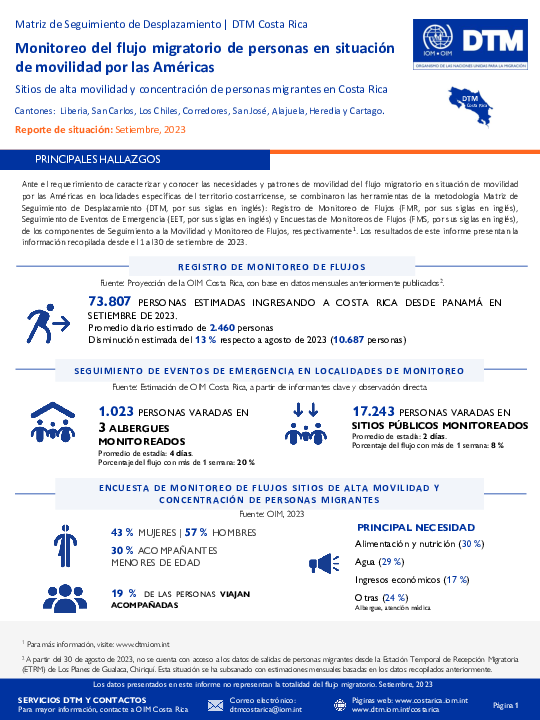
Contact
DTMCostaRica@iom.int
Language
Spanish
Location
Costa Rica
Period Covered
Sep 01 2023
Sep 30 2023
Activity
- Flow Monitoring
- Mobility Tracking
- Event Tracking
Cantones: Liberia, Los Chiles, San Carlos, Heredia, Alajuela, Cartago, San José y Corredores.
Costa Rica, al igual que los demás países de la región centroamericana, se ha caracterizado por ser un corredor migratorio para personas que transitan de manera terrestre desde el sur hasta el norte de América y que tienen como destino los países del norte del continente. Este flujo en situación de movilidad por las Américas se encuentra compuesto principalmente por personas de la República Bolivariana de Venezuela, Cuba, Haití, Ecuador, así como personas provenientes de otros países de Suramérica, África y Asia.
Según estimaciones de la OIM Costa Rica, durante setiembre ingresaron al país 73.087 personas, un promedio de 2460 personas por día y estimando una disminución de un 13% con respecto a agosto de 2023. Además, se identificaron 1.023 personas varadas en los albergues monitoreados y 17.243 personas varadas en los sitios públicos visitados.
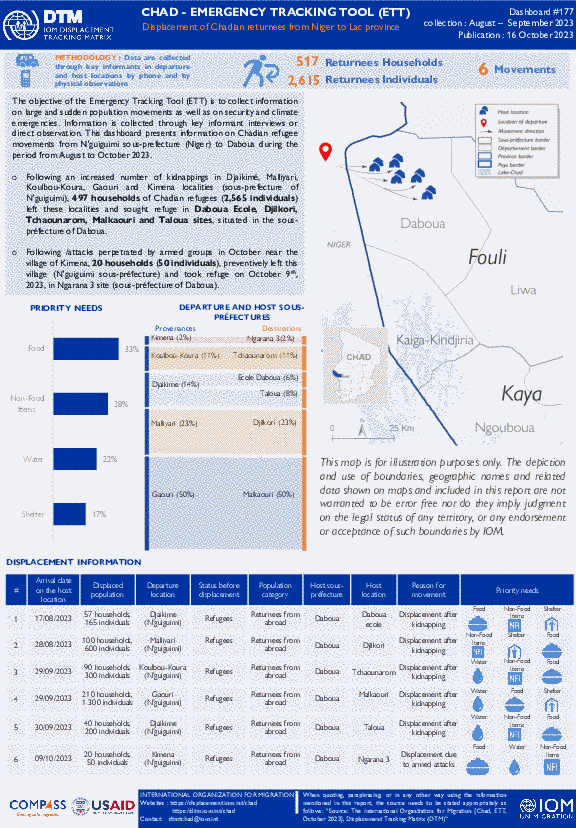
Contact
DTM Chad, dtmtchad@iom.int
Language
English
Location
Chad
Period Covered
Aug 01 2023
Oct 09 2023
Activity
- Mobility Tracking
- Event Tracking
The objective of the Emergency Tracking Tool (ETT) is to collect information on large and sudden population movements as well as on security and climate emergencies. Information is collected through key informant interviews or direct observation. This dashboard presents information on Chadian refugee movements from N'guiguimi sous-prefecture (Niger) to Daboua during the period from August to October 2023.
- Following an increased number of kidnappings in Djaikimé, Malliyari, Koulbou-Koura, Gaouri and Kimena localities (sous-prefecture of N'guiguimi), 497 households of Chadian refugees (2,565 individuals) left these localities and sought refuge in Daboua Ecole, Djilkori, Tchaounarom, Malkaouri and Taloua sites, situated in the sous-préfecture of Daboua.
- Following /attacks perpetrated by armed groups in October near the village of Kimena, 20 households (50 individuals), preventively left this village (N'guiguimi sous-préfecture) and took refuge on October 9 th , 2023, in Ngarana 3 site (sous-préfecture of Daboua).
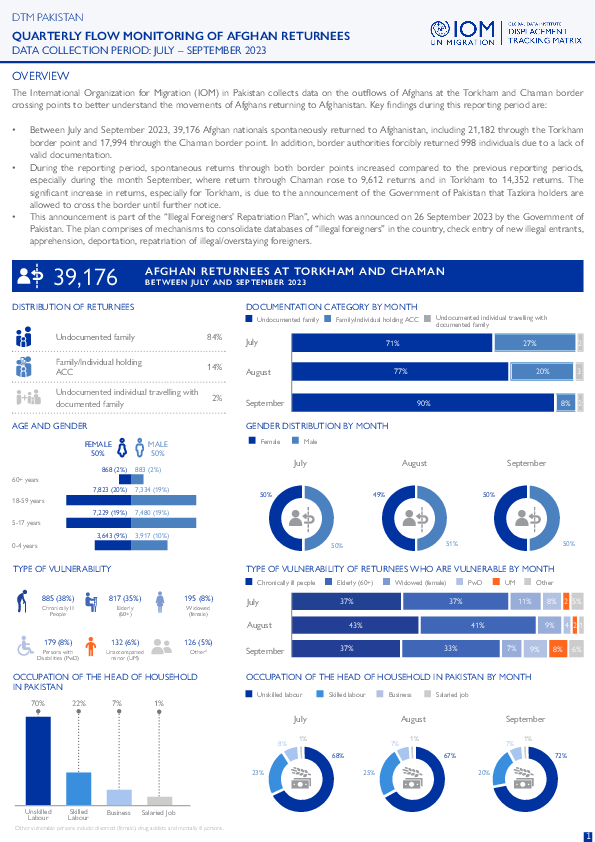
Contact
DTM Pakistan, iomisbdtmremapteam@iom.int
Language
English
Location
Pakistan
Period Covered
Jul 01 2023
Sep 30 2023
Activity
- Flow Monitoring
IOM in Pakistan collects data on the outflows of Afghans at the Torkham and Chaman border crossing points to better understand the movements of Afghans returning to Afghanistan. Key findings during this reporting period are:
• Between July and September 2023, 39,176 Afghan nationals spontaneously returned to Afghanistan, including 21,182 through the Torkham border point and 17,994 through the Chaman border point. In addition, border authorities forcibly returned 998 individuals due to a lack of valid documentation.
• During the reporting period, spontaneous returns through both border points increased compared to the previous reporting periods, especially during the month September, where return through Chaman rose to 9,612 returns and in Torkham to 14,352 returns. The significant increase in returns, especially for Torkham, is due to the announcement of the Government of Pakistan that Tazkira holders are allowed to cross the border until further notice.
• This announcement is part of the “Illegal Foreigners’ Repatriation Plan”, which was announced on 26 September 2023 by the Government of Pakistan. The plan comprises of mechanisms to consolidate databases of “illegal foreigners” in the country, check entry of new illegal entrants, apprehension, deportation, repatriation of illegal/overstaying foreigners.

Contact
DTM Chad, dtmtchad@iom.int
Language
English
Location
Chad
Period Covered
Sep 01 2023
Sep 30 2023
Activity
- Mobility Tracking
- Event Tracking
The purpose of the Emergency Tracking Tool (ETT) is to collect information on large and sudden population movements as well as on security and climate emergencies. Information is collected through key informant interviews or direct observation. This dashboard provides information on movements which occurred during the period from 01 to 30 September 2023, in the Lac Province.
During September 2023, several security incidents occurred in the Lac province and beyond (Niger), resulting in population displacements. A total of 3,546 households (12,627 individuals) were affected by displacement, which represents an increase of 43 per cent compared to August. Among the displaced population, 340 households (1,800 individuals) Chadian refugees who were forced to leave the sous-préfecture of N'guiguimi (Niger) for Daboua sous-préfecture. The vast majority (86%) of affected individuals during September were members of local communities before this displacement. The main reason for displacement was armed attacks (82%). The majority (65%) of displaced persons stayed in the same sous-préfectures (see table on page 2). The three essential needs reported by most displaced persons at their places of displacement were food (29%), non-food items (29%), shelter (23%) and water (19%).

Contact
DTM Nigeria, iomnigeriadtm@iom.int
Language
English
Location
Nigeria
Period Covered
Dec 12 2022
Jan 14 2023
Activity
- Survey
As of February 2023, 2,200,679 individuals were internally displaced in the BAY (Borno, Adamawa and Yobe) states of the north-east region, and 2.17 million individuals returned to their locations of origin. The unpredictability of the security crisis in BAY states has left for fluid mobility in these areas. This, coupled with the closure of major camps in Maiduguri Metropolitan Council (MMC), Jere and Konduga local government areas (LGAs) of Borno State. Many IDPs who resided in these camps have now integrated in host communities where they were displaced, some have reintegrated in their LGAs of origin and others have moved to different LGAs for resettlement.
To help find durable solutions for internal displacement — whether through return to communities of origin, local integration, or relocation – and to prevent new displacements in the region, it is critical to understand the relative levels of stability in locations hosting returnees or displaced populations. IOM launched the Stability Index (SI) in 2019 to evaluate the stability of areas hosting returnees or displaced populations in Nigeria. The SI seeks to understand factors influencing a location's stability to identify priority interventions for transition and recovery, with the goal of strengthening the resilience and stability in this conflict and displacement-affected region. The Stability Index measures perceptions of stability and analyzes factors having a larger impact on the decisions of populations to remain in place or move. The tool is implemented in the BAY states to enable governmental authorities and partners to develop better strategies, and to prioritize resources that link humanitarian, recovery, and stabilization approaches.
This report presents results from data collection of Stability Index Round 3 conducted in Nigeria’s BAY states (Borno, Adamawa and Yobe) between December 2022 and January 2023.
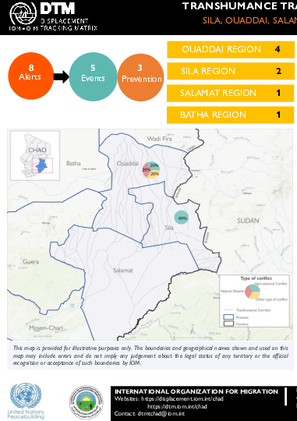
Contact
DTM Chad, DTMTchad@iom.int
Language
English
Location
Chad
Period Covered
Jun 01 2023
Aug 31 2023
Activity
- Survey
- Flow Monitoring
The Transhumance Tracking Tool (TTT) has been implemented in Sila, Salamat, and Ouaddaï regions in order to understand transhumance dynamics at the local level. This tool combines four components: alert, counting, surveys and mapping.
The early warning system identifies unexpected livestock movements and conflicts related to natural resource use or agro-pastoral practices in the regions. It also helps partners (state and non-governmental) understand existing conflict resolution methods and be informed of events as soon as possible in order to reduce tensions. The system shares alerts related to a conflict event or disaster (event alert) or as a result of a massive or unexpected movement of livestock (prevention alert). This report presents the data collected through the alert tool, by key informants of the Confederation of Professional Organisations of Pastoralists and actors in the livestock sector in Chad (COPAFIB) from June to August 2023 in Sila, Salamat and Ouaddai provinces.
Contact
DTM Yemen, iomyemendtm@iom.int
Location
Yemen
Activity
- Mobility Tracking
- Event Tracking
Period Covered
Oct 08 2023 -Oct 14 2023
From 1 January to 14 October 2023, IOM Yemen DTM tracked 4,716 households (HH) (28,296 Individuals) who experienced displacement at least once.
Between 8 and 14 October 2023, IOM Yemen DTM tracked 24 households (144 individuals) displaced at least once. The majority of people moved into/within the following governorates and districts:
- Ma’rib (12 HHs) – Ma’rib City (7 HHs), Harib (3 HHs), Ma’rib (2 HHs) districts. Most displacements in the governorate originated from Ibb and Al Hodeidah.
- Al Hodeidah (8 HHs) – Al Khukhah (6 HHs), At Tuhayta (2 HHs) districts. Most displacements in the governorate were internal.
- Hadramawt (4 HHs) – Ash Shihr (4 HHs) district. All displacements in the governorate originated from Al Hodeidah.
- Al Hodeidah (13 HHs) – Bayt Al Faqih (5 HHs), At Tuhayta (4 HHs), Al Khukhah (1 HH) districts.
- Ibb (5 HHs) – Dhi As Sufal (3 HHs), Al Odayn (2 HHs) districts.
- Ta’iz (3 HHs) – Jabal Habashi (2 HHs), Mawza (1 HH) districts.
Population Groups
Survey Methodology
Unit of Analysis Or Observation
Type of Survey or Assessment
Keywords
Geographical Scope
Administrative boundaries with available data
The current dataset covers the following administrative boundaries
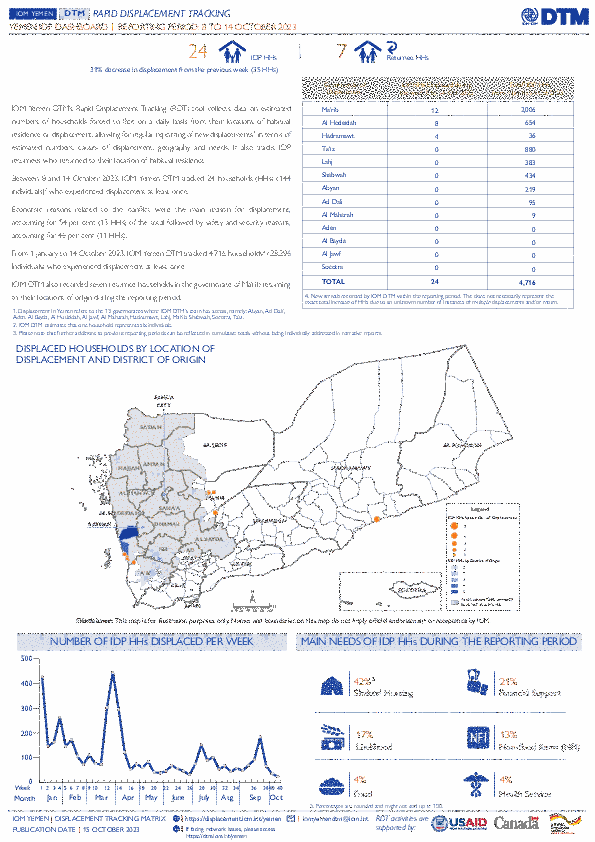
Contact
DTM Yemen, iomyemendtm@iom.int
Language
English
Location
Yemen
Period Covered
Oct 08 2023
Oct 14 2023
Activity
- Rapid Emergency Registration
- Mobility Tracking
IOM Yemen DTM’s Rapid Displacement Tracking (RDT) tool collects data on estimated numbers of households forced to flee on a daily basis from their locations of origin or displacement, allowing for regular reporting of new displacements in terms of estimated numbers, geography, and needs. It also tracks returnees who returned to their location of origin.
From 1 January to 14 October 2023, IOM Yemen DTM tracked 4,716 households (HH) (28,296 Individuals) who experienced displacement at least once.
Between 8 and 14 October 2023, IOM Yemen DTM tracked 24 households (144 individuals) displaced at least once. The majority of people moved into/within the following governorates and districts:
- Ma’rib (12 HHs) – Ma’rib City (7 HHs), Harib (3 HHs), Ma’rib (2 HHs) districts. Most displacements in the governorate originated from Ibb and Al Hodeidah.
- Al Hodeidah (8 HHs) – Al Khukhah (6 HHs), At Tuhayta (2 HHs) districts. Most displacements in the governorate were internal.
- Hadramawt (4 HHs) – Ash Shihr (4 HHs) district. All displacements in the governorate originated from Al Hodeidah.
The majority of people moved from the following governorates and districts:
- Al Hodeidah (13 HHs) – Bayt Al Faqih (5 HHs), At Tuhayta (4 HHs), Al Khukhah (1 HH) districts.
- Ibb (5 HHs) – Dhi As Sufal (3 HHs), Al Odayn (2 HHs) districts.
- Ta’iz (3 HHs) – Jabal Habashi (2 HHs), Mawza (1 HH) districts.
Contact
DTM Sudan, DTMSudan@iom.int
Location
Sudan
Activity
- Mobility Tracking
- Baseline Assessment
Period Covered
Apr 15 2023 -Oct 05 2023
From 15 April 2023, armed clashes erupted between the Sudanese Armed Forces (SAF) and the Rapid Support Forces (RSF). As a result of the military clashes, DTM Sudan estimates that 4,551,795 Individuals (907,833 Households) have been recently internally displaced. The IDP caseload has been observed in 4,647 locations across all of Sudan’s 18 states. The highest proportions of IDPs have been observed in River Nile (12.66%), South Darfur (11.19%), East Darfur (11.01%), Aj Jazirah (8.07%), Northern (7.97%), and North Darfur (7.37%). Field teams report that the IDPs observed were originally displaced from eight states. The majority (3,120,044 IDPs, 68.55%) have been reportedly displaced from Khartoum state; followed by South Darfur (14.58%), North Darfur (7.97%), Central Darfur (3.99%), West Darfur (3.75%), South Kordofan (0.72%), North Kordofan (0.43%), and Aj Jazirah (0.01%). DTM Sudan also estimates that approximately 2.63% of the IDP caseload are non-Sudanese nationals. In addition to the internal displacement, the conflict in Sudan has caused the Mixed Cross-Border Movements of 1,237,103 individuals into neighbouring countries namely Egypt, Libya, Chad, Central African Republic, South Sudan and Ethiopia. 65% of arrivals tracked in those countries were Sudanese nationals and 35% estimated foreign nationals and returnees. The majority of arrivals were reported in Chad (40.5%), Egypt (26.1%),and South Sudan (24.6%).
A more detailed version of this dataset is available, to get access kindly click on the "Request Access" button.
Population Groups
Survey Methodology
Unit of Analysis Or Observation
Type of Survey or Assessment
Keywords
Geographical Scope
Administrative boundaries with available data
The current dataset covers the following administrative boundaries
